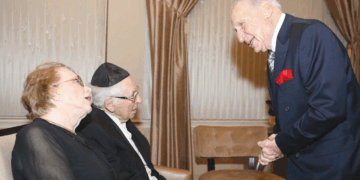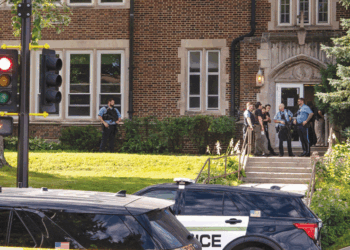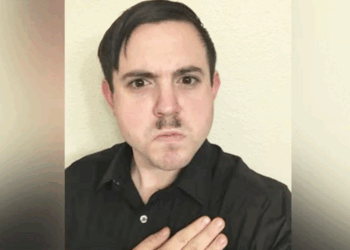Perhaps by the time you read this editorial, Gov. Mark Dayton will have called the Legislature back for a brief special session and hammered out an agreement to resolve the $1.8 billion gap between his and the Legislature’s budget proposals; or some type of interim funding scheme will be devised to keep the lights on in some Minnesota government offices.
But it might be just as likely that I have won the Powerball drawing this week, and my mail is being routed to a villa on St. Lucia.
If you have not been paying close attention to the machinations of Minnesota state government, most of the apparatus is slated to shut down on July 1, absent the governor signing a money bill that addresses a $5 billion budget shortfall. As the AJW goes to press this week, lawyers for Gov. Dayton and Attorney General Lori Swanson are scheduled to argue their separate petitions filed in Ramsey County District Court that seek to keep various essential state services operating. The court will decide what meets the definition of “essential.”
Minnesota Public Radio reported this week that during a partial state government shutdown in 2005, prisons, state-run hospitals, nursing homes, law enforcement and power production continued to operate.
On the Republican side of the budget quagmire, four state senators petitioned the Minnesota Supreme Court on Monday to stop the Ramsey County court from determining what gets funding if the state shuts down. The Star Tribune reported that the GOP senators — Warren Limmer, Scott Newman, Sean Nienow and Roger Chamberlain — contend that only constitutional and statutory mandates should be funded. Their petition argues that the courts should not be “used as pawns in a political chess game,” as happened in 2001 and 2005 government shutdowns.
Common sense would suggest that some functions of government must continue in the case of a shutdown: courts will be needed to process those arrested; hospital patients and prison inmates require food and care, etc.
In the case of local Jewish social service agencies, the budget impasse and the looming state shutdown present serious concerns. In the unfolding battle of the state budget (over the coming two years), Sholom’s state revenues would be cut by about $1.1 million, under Gov. Dayton’s proposed budget for health and human services funding, as I reported in my March 4 editorial (“Gophers and badgers”).
By contrast, the GOP’s biennial budget proposal would largely spare nursing homes, as far as the state rate for Medicaid/Medical Assistance reimbursement; but their proposed health and human services appropriations would cut some $215,000 in Medicaid-funded assisted living services to Sholom, according to Ethan Roberts, director of the Twin Cities Jewish Community Government Affairs Program.
In an action alert sent to Jewish agencies in mid-May, Roberts mentioned that the Legislature’s budget “also freezes enrollment levels to the Medicaid Elderly Waiver (EW) program at the June 30, 2011, levels for the next two years. This enrollment freeze will limit the number of seniors that can be served by Sholom, as well as JFCS [Jewish Family and Children’s Service of Minneapolis], JFS [Jewish Family Service of St. Paul] and the St. Paul JCC, through their home and community-based EW services, including meals on wheels, case management, adult day care, medical translation and transportation.”
If seniors are no longer served by these programs, some of them might have to go into nursing homes, according to Roberts’ analysis.
In explaining the discrepancies between the budget proposals of the governor and the Legislature, Roberts pointed out that the Republican Legislature’s budget proposal eliminated Gov. Dayton’s funding for Medicaid expansion, about $600 million, which would have enrolled “very poor adults with bad medical issues.” This would have been a “real boon for hospitals,” Roberts commented. With the savings in this area, the Republicans proposed to keep nursing home funding stable.
At this point it’s difficult to predict how the shutdown scenario will unfold. The elements kept shifting early in the week.
In a conversation on Monday, Roberts warned that Gov. Dayton’s petition to the Ramsey County court did not include nursing homes and assisted living programs among the essential services to be funded during a shutdown. Apparently, the governor rationalized that services would still be provided to patients and clients; but the service providers would not be paid until some future date. However, late on Monday, Roberts sent a memo to local Jewish agencies explaining that the governor had changed course and would ask the court to continue Medicaid and Medical Assistance payments through the course of a government shutdown. This was “welcome news” for agencies serving older adults, according to Roberts, who wrote that “Sholom alone receives approximately $975,000 per month in Medicaid payments.”
In a statement provided to the Jewish World on Tuesday, Mike Hanson, Sholom’s chief financial officer, expressed his agency’s gratitude to Gov. Dayton for expanding the list of essential state services “that he wants continued during a government shutdown, including Medicaid funding for long-term care. Having previously listed nursing home and assisted living services as essential, it only makes sense to provide Sholom with the approximately $1 million in monthly Medicaid payments necessary to deliver these services to vulnerable low-income older adults. Looking beyond the immediate potential for a government shutdown to the yet-to-be-agreed-upon 2012-2013 state budget, Sholom continues to work closely with its allies at the Jewish Community Relations Council and Aging Services of Minnesota, which represent Sholom at the Minnesota State Capitol, to advocate for a fair budget solution which maintains Minnesota’s historical commitment to older adults who reside in our two nursing homes, as well as access to Sholom’s full spectrum of home- and community-based assisted living services.”
Again, it is still up to the Ramsey County court to determine what funding will continue after the July 1 deadline. (The Star Tribune reported Saturday that the House Republican leaders assured legislators and staff that they will continue to draw paychecks during a government shutdown. “We can’t get the government going again unless we pass bills,” House Majority Leader Matt Dean, R-Dellwood, told the newspaper, which noted that a memo to House staffers advised them that they can refuse their pay. Gov. Dayton and Sen. Majority Leader Amy Koch have both stated that they will not accept paychecks.)
In my March 3 editorial, I compared the situations in Minnesota and Wisconsin; little has changed in Minnesota’s budget battle between DFLers and Republicans. As I noted then, Gov. Dayton proposes to resolve the budget shortfall with a mixture of spending cuts and tax increases for the wealthiest families in Minnesota. The Republicans, who took over both houses of the Legislature in the 2010 elections, oppose Dayton’s tax equity proposal. So, the political dimension of the budget problem revolves around the growing concentration of wealth and political power in the hands of a very few, and the stubborn refusal by Republicans to make them pay their fair share of taxes. Dayton’s tax equity proposal would increase taxes on the richest 2 percent of Minnesota families.
In America today the top 1 percent of households receive 21 percent of total income, according to the Center on Budget and Policy Priorities (CBPP). This percentage of total wealth is down from recent peaks, but is still among the highest percentages since the late 1920s.
Perhaps you’ve heard the adage, “The rich are getting richer”? Richer than you probably think.
Over recent years, from 2002-2007, income gains flowed to this top 1 percent of U.S. households, according to CBPP. Real (inflation-adjusted) income for this 1 percent of households grew more than 10 times faster than the income of the bottom 90 percent of U.S. households.
And the richest of the rich, the top one one-hundredth of 1 percent (0.01 percent) of U.S. households, saw their average annual income rise by 123 percent from 2002 to 2007 — an average of $20 million. “Even after incurring large losses in 2008, the wealthiest 0.01 percent of households held 5 percent of total income — about the level reached at the peak of the last expansion in 2000, and higher than the prior peak in 1928,” according to CBPP.
The super-rich write this country’s tax laws, and they pay a lower percentage of their income in taxes than do middle-class earners. The size of the U.S. economy has about doubled since 1980, “but almost all the gains have gone to the super-rich,” says Robert Reich, the former Labor secretary in the Clinton administration. “The super-rich have almost 40 percent of the nation’s entire wealth.”
Before 1980, the top tax rate was more than 70 percent, according to Reich; now the super-rich have pushed the top tier down to 35 percent. He says that the richest 400 Americans pay only 17 percent of their income in taxes. The upshot of this growing economic equality and taxation skewed to benefit the wealthy is “huge budget deficits.”
(I highly recommend going to: robertreich.org, and watching Reich’s Web video, “The Truth About the Economy in 2 Minutes and 15 Seconds.”)
Minnesotans must become engaged in the governmental crisis that will be playing out in the coming weeks. Unless people power prevails over the great power wielded by a wealthy few, Minnesota might solve its budget mess by making life more miserable for the poor, elderly and infirm. This is not the kind of social justice prescribed by our Jewish prophetic tradition; it is injustice.
— Mordecai Specktor / editor@ajwnews.com
(American Jewish World, 6.24.11)



















Comments 0